AVISO SOBRE MODULO DE PAGO
Por cierre de ejercicio fiscal del año 2025 en nuestra Institución, el módulo de pago ha quedado inactivo desde hoy 3 de diciembre de 2025, reanudando funciones en enero de 2026. Cualquier información al respecto de los procesos de los artículos enviados, comuníquese al correo era@ujat.mx
Read more about AVISO SOBRE MODULO DE PAGO
